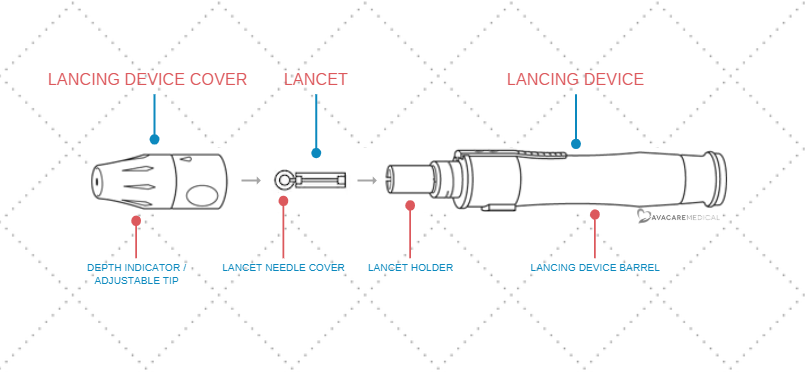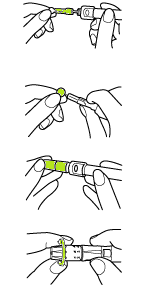Free shipping orders over $50
Lancets / Lancing Device
Browse our selection of efficient, quality and sterile lancing devices and blood lancets and get accurate blood sugar readings every time. Whether you prefer the popular One Touch Delica o the Accu Chek Fastclix lancet device, we have all your lancing needs here. To learn more about these unique products designed for diabetes management, read our helpful guide below. Read More...
-
Medlance Plus Safety Lancet
Starting at $40.69 -
SensiLance Pressure Activated Sterile Safety Lancet
Starting at $16.34 -
Unistik 3 Normal Safety Lancet
Starting at $9.10 -
Unistik 3 Extra Safety Lancet
Starting at $33.84 -
McKesson Push Button Safety Lancet Needle
Starting at $16.30 -
BD Microtainer Safety Lancet
Starting at $87.69 -
McKesson Twist Lancet
Starting at $1.48 -
ReliaMed Safety Lancet
Starting at $17.60 -
ReliaMed Universal Lancet
Starting at $1.28 -
SurgiLance Safety Lancet
Starting at $17.51 -
Unistik 3 Comfort Safety Lancet 28G
Starting at $9.10
I. Lancets
What Are Blood Lancets for Diabetes?
Lancets are small, disposable and usually sterile medical implements that are equipped with a double-edged needle or blade, and are used to obtain small specimens of blood.
What Size Lancet Do I Need?
Lancets come in multiple size options, with each size indicating the length of the needle. The smaller the size (known as the gauge), the thicker the needle. For most people, a size 30 lancet will suffice to get a good finger prick. However, for those with thicker skin, a smaller size needle between 25 - 28 may be more effective as the thicker needle will work better with their skin. On the other hand, patients with very thin skin may prefer a 32 or 33 gauge lancet, as thinner needles cause less pain.
II. Lancet Devices
What is a Lancing Device?
Diabetics use lancet testing multiple times throughout the day in order to monitor their blood sugar levels. The lancet device is loaded with a lancet and then used to perform a finger prick (also known as finger stick) to draw capillary blood for testing.
How do Lancing Devices Work?
Modern lancet devices are generally spring-loaded and are designed to push the lancet pin into the skin very quickly, before (almost instantaneously) retracting it back into the barrel. By doing this, lancing devices provide a small sampling of blood for testing while causing minimal pain. Since the whole process of pricking takes a millisecond, the nerves generally can’t process the impact fast enough to cause pain.
Lancet Device Setting
Before using your lancing device for the first time, set the depth penetration, which can be set to any number from 0 - 10 (exact depth options vary by product), to indicate how deep into the finger the needle should go.
For those with very thin skin, especially patients on corticosteroids or have skin that bruises easily, less depth penetration is preferable. Individuals with thick skin will need the needle to plunge deeper to avoid grazing the finger without retaining a sufficient blood sample.
While your user’s manual should be consulted for exact setting instructions, the following chart will give you a basic idea of the depth setting you may need.
| Size | Indicated Use |
|---|---|
|
1 - 2 |
Thin or soft skin; skin that bruises easily |
|
3 - 4 |
Average skin |
|
5+ |
Rough, calloused skin |
How Often Do I Need to Change Lancets?
To avoid contamination and infection, the lancet in the device should preferably be replaced with a new one each time a finger stick is performed. Although a single-user lancet is less likely to spread infection, especially if the user cleans his/her hands before every test, some users find that used lancets don’t perform as well. As the pin is very delicate and can easily become dull or bent, making the prick less precise and therefore less gentle.
If you are not very sensitive, you may find that changing the lancet once a day or even once a week will work for you.
How Do I Load a Lancet Device?
Loading the lancing device is a fairly simple process and will take seconds to complete once you are familiar with it. To load your lancet device correctly, follow the simple steps shown below:


- Remove the lancing device cover to expose the lancet holder.
- Insert the lancet into the lancet holder. To ensure that the lancet is inserted correctly, find and match up the ridge on the lancet to the groove in the lancet holder, then slide the lancet into place.
- Engage the needle by pushing the lancet downwards into the lancing device barrel until it clicks into place. Be sure to do this step before exposing the needle on the lancet to prevent contamination.
- Remove the lancet needle cover by twisting gently. This cover may be saved to be used as a protective cover when disposing of the lancet after use.
- Close the lancing device by replacing the cap.
- Adjust the depth penetration as needed (see Lancet Device Setting above).
You are now ready to collect your blood sample!
How Can I Make My Finger Pricks Hurt Less?
That pain is more of a problem than you may think. When blood glucose testing is painful, patients may be discouraged from monitoring their glucose levels as often as they should be. Here are some great ways to reduce blood glucose testing pain.
- Always replace the lancet. Used lancets become bent, dull, and in general, more painful on impact. For painless pricks, use a new lancet for every test - even if you do seven tests a day.
- Check your lancet size. The higher the gauge size, the thinner the pin. The thinner the pin, the less pain you’ll feel. So if you don’t need a thick pin to pierce your skin, don’t use a lancet that’s less than 30g.
- Check your penetration depth. If the tip of your lancing device is set to penetrate deeper than necessary, consider lowering the setting so it goes in more gently. See Lancet Device Setting for more information on penetration depth.
- Use a brand name monitor. Sometimes you need a deeper penetration setting to get enough blood to satisfy your blood glucose monitor. If you’re in pain, you may want to consider replacing your meter for one that is known for its quality - and doesn’t require deep pricks.
- Don’t use alcohol wipes. Alcohol tightens the skin, making blood testing more difficult - and more painful. Besides, alcohol can affect the accuracy of readings. Whether or not you are experiencing a lot of pain, professionals recommend hand washing with soap, not alcohol wipes.
- Alternate fingers. Avoid getting into a habit of pricking the same spot on the same finger every time, as this practice will need to callouses and scars. While callouses may make fingersticks less painful in the short run, alternating fingers is recommended to avoid long term effects.
- Think twice about your thumb. While alternating fingers may be a great idea, you may want to avoid pricking your thumb as it gets a lot of use and impact throughout the day, which can make the healing process longer and more painful.
- Experiment. There are a lot of alternate sites, such as the forearm, thigh, calf or upper arm, which can be less painful, so do some trial and error to find your pain-free zone. Even better, try getting a sample from your palm, which has been found to be just as accurate as the fingertip but significantly less painful.
- Improve your blood flow. One of the primary reasons that finger pricks can hurt so much is a weak blood flow. To improve your flow, follow these tips:
- Make your hands warm. Use warm water when washing your hands to increase blood circulation and make testing easier.
- Aim to the side. The side of your finger has better blood flow than the tip of the finger (also known as the finger pad). Plus, the location itself hurts less.
- Wait for it. Squeezing your finger can affect the results, so you’ll want to wait for a droplet of blood to form on its own. To encourage this, lower your arm to get the blood flowing downward and massage your finger softly.
At AvaCare Medical, we offer a full range of diabetes care products, including glucometers, sharps containers, and all your lancing device needs. Call our representatives today if you need any help: 1-877-813-7799.














